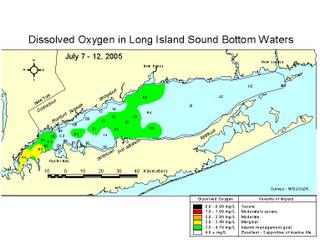Water Quality in the Sound
The information comes from the Connecticut DEP, which sent out its first water quality map of the summer this morning. The map shows that most of the Sound from New Haven to the west had dissolved oxygen concentrations between 3.5 and 4.8 milligrams per liter (shown in green).
(In terms of dissolved, the Sound east of New Haven is essentially a different body of water -- the Sound is wide, has an open connection to the ocean, and gets a huge amount of water from the Connecticut river, all of which tend to keep dissolved oxygen concentrations high.)

The furthest western reaches – the narrows, where hypoxia has traditionally been the worst – had readings between 3 and 3.5 milligrams per liter (shown in yellow).
In an e-mail this morning, Matthew Lyman, of the DEP, explained the readings this way:
DOs were up in the narrows largely due to the remnants of tropical storm Cindy and a lot of east wind on Friday. The latest buoy reading is showing DOs back down below 2.0 mg/L at the western most stations. We will be back out next week.
Oxygen is as important to creatures who live in the water as it is to those of us who live on land. Here’s what the Long Island Sound Study’s website says:
To date, research shows that the most severe effects (such as mortality) occur when dissolved oxygen levels fall below 1.5 mg/l at any time and below 3.5 mg/l in the short-term (i.e., 4 days), but that there are probably mild effects of hypoxia when dissolved oxygen levels fall below 5 mg/l. The levels regularly observed in the Sound during late summer:
-- Reduce the abundance and diversity of adult finfish;
-- Reduce the growth rate of newly-settled lobsters and perhaps juvenile winter flounder;
-- Can kill species that cannot move or move slowly, such as lobsters caught in pots and starfish, and early life stages of species such as bay anchovy, menhaden, cunner, tautog, and sea robin;
-- May reduce the resistance to disease of lobsters and other species; and
-- Diminish the habitat value of Long Island Sound.
The Long Island Sound Study has set interim goals for dissolved oxygen:
-- Maintain existing dissolved oxygen levels in waters that currently meet state standards;
-- Increase dissolved oxygen levels to meet standards in those areas below the state standards but above 3.5 mg/l; and,
-- Increase short-term average dissolved oxygen levels to 3.5 mg/l in those areas currently below 3.5 mg/l, ensuring that dissolved oxygen never goes below 1.5 mg/l at any time.
Obviously, higher readings are better, but it’s hard to say what the current readings predict. The past two summers, DO concentrations have been good right up until mid-August, when they dropped precipitously.
You can see previous water quality maps by clicking on the DEP Hypoxia Maps link to the right.
I think it speaks well of the DEP, by the way, that it makes these maps available so quickly, and I thank Matthew Lyman for including me on his e-mail list.



0 Comments:
Post a Comment
<< Home